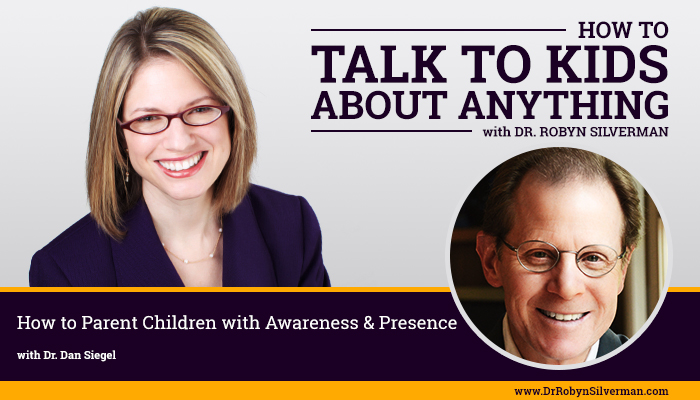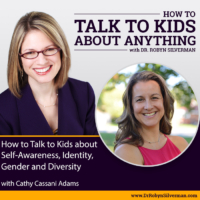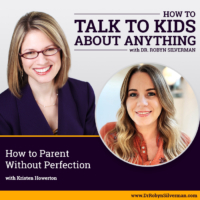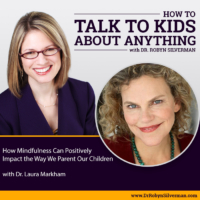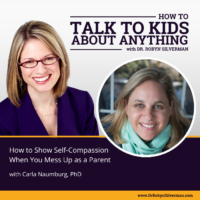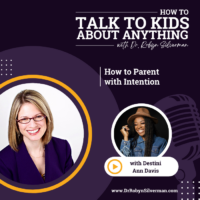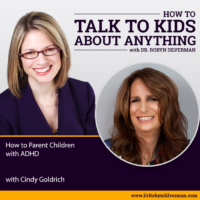Podcast: Play in new window | Download
Subscribe: Apple Podcasts | RSS | More
How to Parent with Awareness
This podcast delves deep into the concept of awareness and how we can become more present in parenting, teaching and coaching when working with children. Using the Wheel of Awareness by Dr. Dan Siegel, we can get more centered and focus on what really matters. Becoming aware can be beneficial to our relationships, our mental health and our physical health!
Parenting these days can be very reactionary. We have lots of pressure and little time and often many feelings of not being enough, 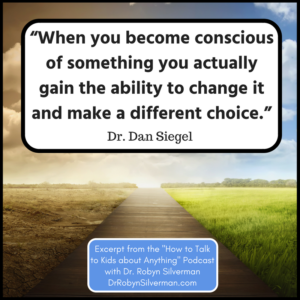 constantly striving, competing with others and overall disconnection. We have big reactions or, perhaps we might say, our big reactions have us. But what if we practiced more aware parenting? What if we become more in touch with our own senses, our mental state, our bodies and our relationship to ourselves and to others and how our awareness could affect our parenting and our lives? When we become aware and reflective of our reactions and what is indeed feeding these reactions, we can become more receptive, calm, balanced, compassionate and positive in the way we parent our kids and more balanced in our own wellbeing. And imagine what we can teach our kids—by showing awareness and practicing awareness, we can then teach them to the do the same in their own lives. Is there a way to cultivate this awareness? Is there a way to teach our kids to practice awareness as children and teenagers? For these questions and more, we turn to our guest today, Dr. Dan Siegel.
constantly striving, competing with others and overall disconnection. We have big reactions or, perhaps we might say, our big reactions have us. But what if we practiced more aware parenting? What if we become more in touch with our own senses, our mental state, our bodies and our relationship to ourselves and to others and how our awareness could affect our parenting and our lives? When we become aware and reflective of our reactions and what is indeed feeding these reactions, we can become more receptive, calm, balanced, compassionate and positive in the way we parent our kids and more balanced in our own wellbeing. And imagine what we can teach our kids—by showing awareness and practicing awareness, we can then teach them to the do the same in their own lives. Is there a way to cultivate this awareness? Is there a way to teach our kids to practice awareness as children and teenagers? For these questions and more, we turn to our guest today, Dr. Dan Siegel.
Dr. Siegel is a clinical professor of psychiatry at the UCLA School of Medicine and the founding co-director of the Mindful Awareness Research Center at UCLA. He is also the Executive Director of the Mind-sight Institute which focuses on the development of mind-sight, which teaches insight, empathy, and integration in individuals, families and communities.
Dr. Siegel has published extensively for both the professional and lay audiences. His four New York Times bestsellers are:
- Mind: A Journey to the Heart of Being Human,
- Brainstorm: The Power and Purpose of the Teenage Brain,
- and two books with Tina Payne Bryson, Ph.D: The Whole-Brain Child and No-Drama Discipline.
- His other books include: The Developing Mind (2nd Ed.), The Pocket Guide to Interpersonal Neurobiology, Mind-sight, The Mindful Brain, The Mindful Therapist, The Yes Brain (also with Tina Payne Bryson, Ph.D), and his book Aware, coming out this month.
Dr. Siegel also serves as the Founding Editor for the Norton Professional Series on Interpersonal Neurobiology which contains over sixty textbooks.
The podcast provides:
- Tips: How to parent with awareness and how awareness can impact all different parts of parenting and relationships
- How trauma or past “baggage” can affect parenting and how being aware of this “baggage” can help this problem.
- A discussion of the wheel of awareness and how this tool can be used by parents and kids.
- Scripts: How to Talk to Kids through the wheel of awareness
Important Messages:
- Awareness helps us out doing old habits.
- When you are aware, you can make a choice that is different than being on automatic pilot.
- You can make your container of consciousness larger which helps you to make better choices.
- Being aware of your feelings—and you are in a threat stage- you are in fight, flight, flee or faint. These are primitive reactions to threat- awareness can help you think through the impulse. You are looking for the pause.
- We can change the size of our container of consciousness—the “salt” is like the challenge of life. Is the container huge or tiny?
- You can use the picture of a wheel of awareness for kids.
- For parents or other adults, you can move through the different segments of the wheel from senses, to body awareness, etc. It distinguishes what you can be aware of as opposed to what you are currently aware of.
- The single point on the rim of the wheel of awareness doesn’t need to be the totality of reality. Your awareness, once expanded, dwarfs that one challenge so that it doesn’t overwhelm or take over—and you can make better choices. You put a buffer or a pause between the impulse and action. You are also cultivating a direct path to additional choices.
- Presence changes our relationships. It helps you to see things as close to the way they are as you can.
- When you are aware in parenting—if you are a child with a parent who is truly present, if you express something, the parent will do three things—(1) receive the signal, (2) make sense of the signal in an open way and (3) respond to what the child expresses in a timely and effective fashion. This is called contingent communication. Then the child is seen for who s/he authentically is. We LEARN who we are through the responses of our caregiver.
- When the caregiver is present, you learn who you are in an authentic way (secure attachment). When a parent doesn’t have presence, it can be impaired in all sorts of ways. This is insecure attachment. You don’t get to see yourself clearly in the words, face and eyes (and responses) of your caregiver. What you are given is a non-present connection. So what you see is more a product of the parent’s or caregiver’s judgment, expectations, pre-existing views of who you should be, who they wish you were, their disappointment in you. This is hidden behind the seen- all you can do as a little kid is soak all that in as if it’s the truth even when it’s not. (It’s one person’s perception, or exhaustion, or lack of skill or frustration—but Not the truth in it’s entirety.) You get a distorted or non-authetic perception view of who you are. This makes it challenging for the child to have presence. You can be fragmented or confused.
- As busy adults, overwhelmed parents, or overworked teachers- it’s hard not to filter life through our baggage. But once we differentiate our filters—the things that happened to us, our biases, our experiences, our judgments, from the truth and what’s really happening, we can be more present and become better parents, teachers and educators. When you feel yourself becoming reactionary, you can turn to your hub, the truth, what’s really happening, and it can become a source of serenity, tranquility, peace. Then the kids can start acting differently. You can carry this place within yourself and it can always be there for you.
- Everyone has a source of strength inside them that doesn’t require a switch on an object to turn it on. It’s something inside all of us and we can cultivate it. Parents can access this – when you feel like you can flip your lid- or feel overwhelmed—you can go to this hub and then a parent can be a reliable source of presence for his/her kids and ultimately for the self.
- Practice- focus attention- senses, internal sensations of the body, open awareness. Bring it on! Don’t control what you are focusing on- just let it all come. No matter how uncomfortable, you get some clarity. You gain a sense of openness. Connection. Joy. Even if it’s stressful, you have presence.
- COAL state of mind.
- Attention, awareness, Intention. Cultivate these three things. This brings on positive changes. Three pillars in one practice. (Available to stream on Dan’s website, link below).
- Third brain- gut.
- What you say to yourself can have a great impact.
- There is too much separation of self. But when you light other people’s candle, you don’t lose anything yourself—but you make the world a better place.
- We are “mwe.” Don’t get rid of the wax- the me- but also we are a we- we are the light that can light other people’s candle.
- The self is a “me plus a we.”
- Who you are is way more than your body.
- Help kids tune into what’s inside them (reflective) and the importance of relationships (relationships) and resilience- they are coming from a grounded place.
- Build this into growth mindset (Dweck) and grit (Angela Duckworth) you are really getting somewhere. When you pursue your passion and you find your purpose- it means you get pleasure from it and have proclivity for it AND it is of service to others then you get persistence (grit!). You get a yes approach to life (Siegel- Yes brain- presence). Then “mwe” can cultivate a brighter world.
- You can develop presence and go from reactivity to receptivity.
Notable Quotables:
- We can use our minds and our relationships to change our lives, the structure of our brains and even improve the health of our bodies by using awareness.”
- “When you are conscious of something you actually have the ability to change what you are doing and to make a choice.”
- “When you are aware, you can make a choice that is different than the one you might make when you are on automatic pilot.”
- “This wheel of awareness is really exciting because whether you are 5 or 55, you can use it to change your life.”
- “You can have an impulse and then a space between the impulse and the action that makes all the difference in developing what we call emotional intelligence and social intelligence.”
- “Presence is a receptive, open state of awareness that is not being restricted, constrained or filtered by a bunch of preconceived ideas, judgments or altered perception.”
- “We learn who we are through the responses of our caregiver. When the caregiver is present, you learn who you are in an authentic way. When a parent doesn’t have presence, it can be impaired in all sorts of ways. This is insecure attachment.
- “Everyone has a source of strength inside them that doesn’t require a switch on an object to turn it on. It’s something inside all of us and we can cultivate it. Then we learn to be present for others and ultimately, present for ourselves.”
- “If I say, ‘I hate myself,’ I actually activate circuitry of hatred in my brain towards me! If I say; ‘you’re doing fine,’ I actually activate kind regard towards myself. When you do this for other people, you don’t just activate empathy of compassion but also empathic joy as in ‘I really wish joy and success for other people.’”
- “It’s as if the culture wants a child to think of himself as a candle and who they are is the wax of the candle. They should have the shiniest wax to distinguish themselves and in middle school or high school or college they will be assessed on the shininess of their wax. Ultimately, you are trying to gain entry to the most elite graveyard. It’s a race to nowhere. And if you see another candle next to you, you want to blow out the flame so you are the only flame left. Then when you apply to a college, they’ll pick you. This gets in the way.”
- “Think about another way of living where you are not just the wax of the candle but also the light. And your job is to lean over and light other people’s wick. What did it take away from my flame to light someone else’s candle? Nothing. But it made the world a brighter place.”
- “It’s a ‘me plus a we.’ You are not a solo self. You are an inter-self and intra-self. We can make these changes in the world.”
- “You want to be competitive? Be competitive with the world’s problems. Let’s harness the capacity for collaboration and connection. There’s a lot of work for us to do!”
- “You can cultivate presence from the inside out.”
Resources:
- www.DrDanSiegel.com
- Aware: The Science and Practice of Presence–The Groundbreaking Meditation Practice
- The Yes Brain: How to Cultivate Courage, Curiosity, and Resilience in Your Child
- Brainstorm: The Power and Purpose of the Teenage Brain book
- The Whole-Brain Child Workbook: Practical Exercises, Worksheets and Activities to Nurture Developing Minds
- No-Drama Discipline Workbook: Exercises, Activities, and Practical Strategies to Calm The Chaos and Nurture Developing Minds

